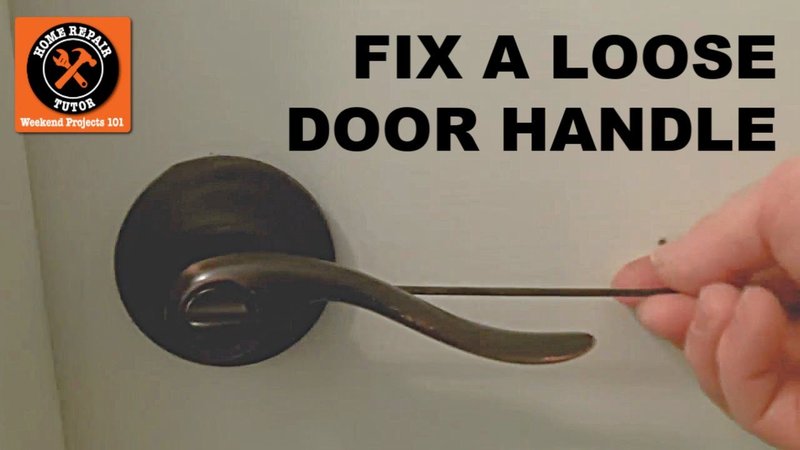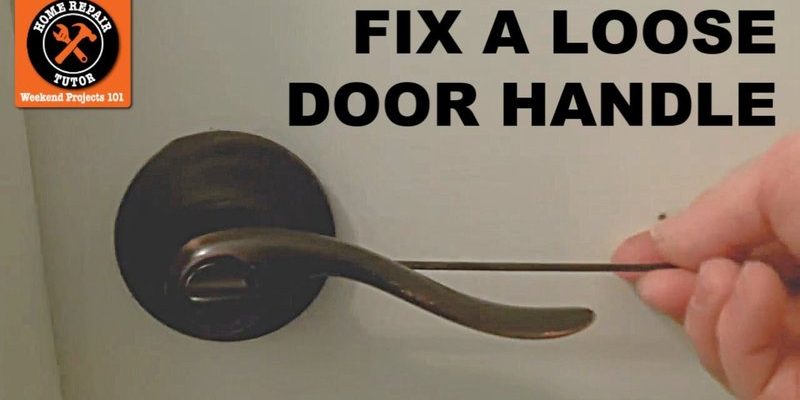
Here’s the thing: a loose handleset isn’t just annoying. It makes your door feel less secure and can even shorten the lifespan of both your lock and your door frame. But don’t worry—tightening up a loose entry door handle is something you can handle with a screwdriver, a bit of patience, and a couple of tricks you might not know yet. Let me explain how it all works, step by step, so you (and your door) can breathe easier.
Why Handlesets Get Loose On Old Wood Entry Doors
You might be wondering why your door handleset even gets loose in the first place. Honestly, it’s a mix of simple wear and tear and the way wood behaves over time. Wood expands and contracts with humidity, and as seasons change, so does your door. Those tiny movements can nudge screws out, or even warp the holes a bit, making things feel less solid.
Another culprit can be the hardware itself. Handlesets—whether you’ve got a classic Yale, a nostalgic Baldwin, or a newer Kwikset—depend on tight screws to keep everything in place. If you use your front door a lot (and who doesn’t?), every twist and pull adds up. It’s sort of like how a favorite chair creaks after a while; it’s just a sign that life is happening.
Plus, older wood entry doors were often made with softer woods or have been painted, sanded, and refinished over the years. That adds up to holes that aren’t as snug as they once were. Sometimes, you’ll even spot the screws spinning in place and not grabbing the wood. That’s a classic sign the frame is worn and needs a little extra TLC—maybe even a trick or two beyond basic tightening.
Tools And Materials You’ll Need
Before you start repairing a loose handleset on an old wood entry door frame, let’s round up what you’ll actually need. Honestly, most of it’s standard stuff you probably already have. But there are a couple of add-ons that can make life easier, especially if you run into stripped screw holes or a handleset that just won’t stay tight.
- Screwdrivers (usually Phillips, sometimes a flathead)
- Allen wrench (for certain brands like Schlage or Baldwin)
- Wood glue or toothpicks (for stripped holes)
- Replacement screws (matching your current hardware)
- Drill (optional for pilot holes)
- Level (to make sure your handle isn’t getting crooked)
- Soft cloth (to clean up dust and debris)
If your handleset is electronic—like some newer Yale smart models—don’t forget to pick up fresh batteries and locate the reset or sync code, just in case you need to remove and reinstall the lock. Most repairs are manual, but it’s good to be ready in case you need to troubleshoot the electronic side while you’re at it.
Step-By-Step: Tightening A Loose Handleset
Let’s actually get our hands dirty—figuratively, at least. Here’s a rundown, step by step, to repair a loose handleset on an old wood entry door frame. Each step has its own little quirks, depending on your door and the brand of your handleset.
- Remove the handleset from the door. Start with the visible screws on the inside of the door. Don’t force anything, and keep a hand on the outside handle so nothing falls.
- Inspect the mounting holes. Are they stripped out, full of dust, or even slightly enlarged? Give them a quick cleaning with a soft cloth. If the holes are stripped, you’ll need to fix them (more on that in the next section).
- Tighten all mounting screws. Use a screwdriver to snug them up, but don’t overdo it—if you go Hulk-mode on the screws, you’ll risk splitting the wood or stripping the heads. For handlesets with hidden set screws (like Schlage or Baldwin), use the appropriate Allen wrench and check for a small screw underneath the lever or knob.
- Reinstall the handleset. Line everything up, and replace the screws. Use a level to make sure everything is straight before fully tightening down.
- Test the handleset. Gently wiggle the handle and operate the lock a few times. If it’s solid, you’re set. If not, keep reading—the next section covers what to do if the holes just won’t hold a screw anymore.
Don’t rush; if you take your time and double-check your alignment, your handleset will feel brand new—without calling a pro.
Fixing Stripped Or Worn Screw Holes In The Door Frame
Sometimes, even after tightening everything, your handleset still feels loose. If the screws keep spinning or just don’t grab the wood, it’s time for a quick fix. Here’s the trick: you want to “reset” the hole so the screw has something to bite into again.
A super-easy method? Grab some wood glue and toothpicks (or wooden matchsticks). Here’s what you do:
- Squirt a little glue into the stripped screw hole.
- Jam in as many toothpicks or matchsticks as you can—break them off flush with the door frame.
- Let the glue dry (about 30 minutes is usually enough).
- Screw the hardware back in—now the screw will have a fresh, tight grip.
If the hole is really oversized, you can patch it with a small piece of dowel and glue. Drill a pilot hole after the glue dries to guide the screw. And if your entry door is a very old, soft wood, you might want to use slightly longer screws to reach deeper, firmer wood inside the frame. Just make sure you’re not driving screws so deep that you poke through to the outside!
Common Handleset Problems And How To Troubleshoot Them
Even after you repair a loose handleset, a few other annoying issues can pop up. Some are easy to troubleshoot yourself, while others might mean it’s time for some new hardware.
- Handle still wiggles after tightening: The hardware might be warped or damaged. Check for bent mounting plates or cracked trim. If you spot damage, replacement is usually the best fix.
- Lock feels sticky or hard to turn: Try lubricating the lock mechanism with a graphite-based spray. Avoid oil-based lubricants—they attract dust and can gum things up over time.
- Electronic handleset acting up: If your keypad or smart lock isn’t working right after you’ve reinstalled it, check the batteries first. Sometimes, removing and replacing the batteries can force a reset or help it to resync with your remote or smart home hub.
- Screws keep loosening up frequently: That points to either soft wood or vibration from a heavy door. Consider using thread-locking compound on the screw threads, or even switching to specialty wood screws for a firmer hold.
If your handleset is decades old, there’s no shame in replacing the whole thing with a modern set—especially if you want better security or to pair with a smart remote system.
When To Replace Versus Repair Your Handleset
Here’s a question a lot of people ask: “Should I just repair the loose handleset on my old wood entry door frame, or is it finally time to swap it out?” There’s no one-size-fits-all answer, but there are a few signs the hardware might be past its prime.
- Visible cracks, chips, or rust on the handleset hardware or strike plate
- Repeated trouble with looseness, even after repair
- Lock mechanism jams often, or the key doesn’t turn smoothly
- Upgrading security—for example, if you want to sync with a smart lock remote or use better battery-powered features
If you decide to replace, you’ll get the chance to upgrade to a more secure model. Many modern handlesets, like those from Schlage, Kwikset, or Yale, offer features like easy code changes, better pairing with remotes, and updated designs to match your style. But if your vintage hardware has heart—and you just want it to feel sturdy again—there’s nothing wrong with sticking with what you’ve got.
Tips For Keeping Your Old Wood Entry Door Sturdy
Once you’ve repaired that loose handleset, it makes sense to give the whole door some love. After all, the handleset is only as solid as the wood it’s attached to. Here’s how you can make sure your old wood entry door frame stays in good shape:
- Check weatherstripping regularly. Gaps let moisture in, which can soften and warp the wood.
- Touch up paint or sealant every couple of years. This helps keep water out and wood strong.
- Lubricate hinges and locks every six months with the right type of lubricant.
- Inspect for soft spots or rot. Press gently around the handleset area—any spongy feeling means you may need more extensive repair.
Little, routine touch-ups make life easier in the long run—and keep your door’s “handshake” strong and trustworthy.
Final Thoughts: Enjoy That Satisfying, Solid “Click” Again
Repairing a loose handleset on an old wood entry door frame might sound like a chore, but it’s honestly one of those little home fixes that pays off every single day. In just an afternoon, you can go from a wobbly, nerve-racking handle to that satisfying, solid *click* every time you close your door. Whether you’re working with a Schlage, Baldwin, or your trusty, no-name vintage hardware, a bit of know-how and care can make even an old door feel new again.
So next time your door handle gives that tell-tale jiggle, don’t stress. Grab your screwdriver and give it the attention it deserves. You might be surprised how much more secure—and cheerful—your old front porch will feel.
